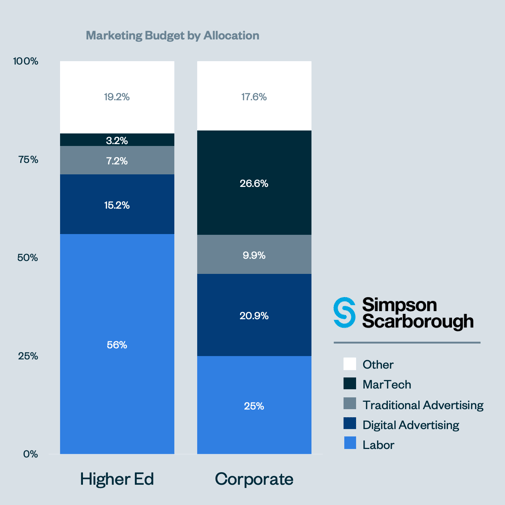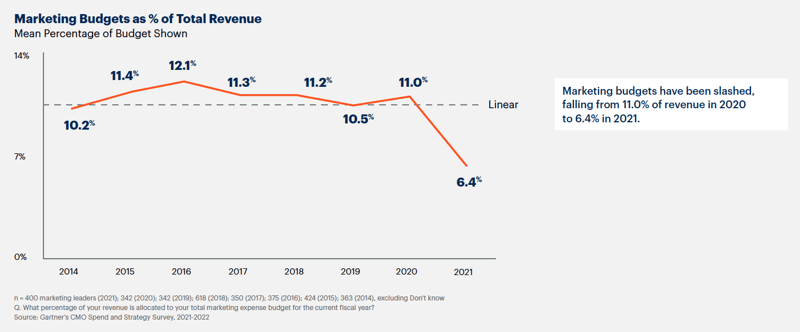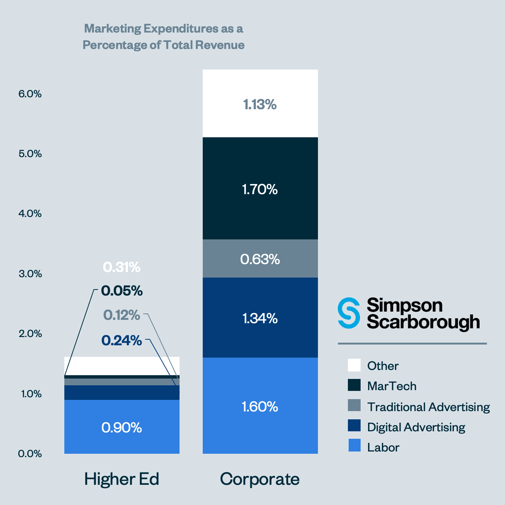Editor's Note: Back at AMA in 2019, I spoke with a CMO from a large public institution who shared his frustration for not only how his institution resourced its marketing efforts, but how they resourced all strategic priorities across the institution. Below is a paraphrased anecdote he shared that's stuck with me ever since.
"In the business world, you might have 3-5 strategic priorities that are funded with specific plans and metrics for how progress will be measured and success will be realized. In higher ed, it seems like you might have 20 or 30 strategic priorities — none of which have (material) funding, much less metrics for success.
A strategic priority means you've identified a critical area in need of growth, innovation, or improvement and have allocated the resources necessary to achieve success. You can't take the same people, give them the same resources and expect something to change. Expecting a different outcome without changing your inputs is completely meaningless."
Every time we collect data for the newest version of our Higher Ed CMO Study, all eyes are on an oft-cited (and equally lamented) aspect of the survey — the central marketing budget. In this year's CMO Study, we tried to bring greater context and comparison points in an effort to allow institutions to better understand how they compare to their peers — whether defined by Carnegie classification, institution type, enrollment size, or even tuition dependency. But for all that added context, one data point stood out like a sore thumb (as it has every time we've conducted the study):
75% of Lead Marketers say they do not have the budget needed to meet the expectations of leadership.
What we really needed was comparison data outside of higher ed. How do higher ed marketing budgets compare to other industries? Fortunately, Gartner produces an annual corporate CMO Spend Survey with benchmarks from the corporate world which allowed us to study the differences in how industries invest in marketing compared to higher education.
How Higher Education and Corporate Marketing Budgets Compare
We began by assessing differences in marketing budgets as a percentage of allocation. For the sake of simplicity and to align with Gartner budget breakouts, we categorized marketing expenditures by labor, digital advertising, traditional advertising, martech, and other.

Higher ed allocates more than twice as much of its marketing budget to labor
- Higher ed allocates more than half its entire budget (56%) to labor expenses.
- In comparison, corporations allocate just 25% of their marketing budget to labor.
Corporations allocate nearly 9x of their budget to MarTech than higher ed
- Proportionally, the greatest difference in budget allocations is the investment in martech.
- Corporations allocate more than a quarter of their entire marketing budget to martech compared to just over 3% in higher education.
Corporations allocate significantly more budget to advertising
- Corporations allocate nearly 40% more in total advertising compared to higher education (30.8% to 22.4%).
- Notably, both spend nearly identical proportions of their total advertising budget on digital versus traditional media (both 68% digital, 32% traditional).
Comparing Marketing Budget Allocations as a Percentage of Total Revenue
The real contrast between marketing budgets in higher education versus the business world is found in the organizational marketing investment as a whole. In other words, the amount allocated to marketing as a proportion of total revenue.

Source: Gartner Corporate CMO Spend Survey
For the past seven years, corporations averaged investing just over 11% of total revenue to marketing. In 2021, that dropped precipitously — no doubt a consequence of the pandemic’s economic impact — to just 6.4% of total revenue. Still, corporations invest 4x more compared to higher education which averages allocating just 1.6% of total revenue to marketing expenditures.
Corporations invest 4x more in marketing than higher education

Corporations spend more on marketing labor overall
- While higher education allocates more of its marketing budget to labor, corporations spend nearly 80% more on marketing labor in total as a percentage of revenue.
- In fact, corporations spend as much on their marketing labor as higher ed does on all marketing investments combined.
Corporations invest more in MarTech than higher ed spends on all marketing expenditures combined
- Corporations previously outspent higher education in their investments in martech by nearly 9:1 as a proportion of their marketing budgets.
- As a percentage of total revenue, that difference becomes even more jarring. For every $100 that higher education invests in marketing technology, corporations invest more than $3,225.
Corporations spend 450% more on advertising than higher ed
- Corporations allocate 40% more of their marketing budget to advertising, they spend nearly 4.5x more on advertising as a percentage of total revenue than higher ed.
- In fact, corporations spend about 25% more on advertising than higher education spends on all marketing expenditures combined.
Where Does Higher Ed Marketing Go From Here?
It’s worth reiterating that this comparison is using data from a year where corporate marketing investment as a percentage of total revenue had dropped substantially compared to its norm, while higher ed’s investment as a percentage of revenue was in line with our findings from the 2019-20 Higher Ed CMO Study.
We don't believe that the challenges facing higher education can be solved simply by increasing marketing budgets. Rather, our goal is to provide some context as to the state of institutional investment in a critical area often overly scrutinized and perpetually underfunded.
Still, it begs the question — what would the net impact be to an institution that, while not able to increase its marketing budget four-fold, did take the steps necessary to consolidate and align all marketing expenditures while employing a cohesive marketing strategy across its institution? Higher education is unique in that its customer life cycle from prospect to student to alumnus to donor may span several decades.
What long-term growth could be realized by removing all point solutions and integrating data, systems, and tools alongside an integrated strategy with a cohesive budget? Beyond economies of scale and newfound efficiencies, what impact could this achieve in growing brand affinity, driving enrollment growth, and maximizing fundraising over time?











